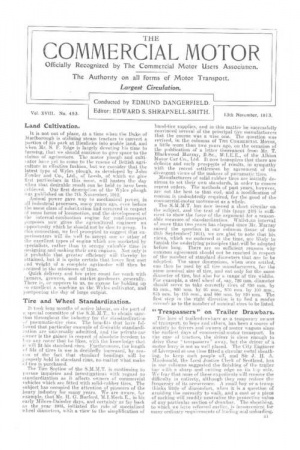Tire and Wheel Standardization.
Page 1

If you've noticed an error in this article please click here to report it so we can fix it.
It took long months of active lab-our, on the part of a special committee of the S.M.M.T., to obtain sanction throughoutthe industry for the standardization of pneumatic-tire rims. The benefits that have followed that particular example of desirable standardization are universally admitted, and the private-car owner is the gainer in respectof absolute freedom to lily airy cover that he likes, with the knowledge that it will fit his standard rims. Furthermore, the length of life of tires in use is decidedly increased, by reason of the fact that standard headings will be properly held in standard rims, no matter what make of tire. is purchased.
The Tire Section of the S.M.M.T. is continuing to pursue inquiries and investigations with regard to standardization as it affects owners of commercial vehicles which are fitted with solid-rubber tires. The subject has occupied the attention of pioneers of the heavy industry for many years. We are aware, for example, that Mr. H. G. Burford, M.I.Mech.E., in his early Milnes-Daimler days, and certainly as far hack as the year 1905, initiated the rule of specialized wheel diameters, with a view to the simplification of
band-tire supplies, and in this matter he successfully convinced several of the principal tire manufacturers that the course was a wise one. The question was revived, in the. columns of THE COMMERCIAL MOTOR, a little more than two years ago, on the occasion of the publication of a letter thereanent from Mr. T. Blackwood Murray, B.Sc., M.I.E.E., of the Albion Motor Car Co., Ltd. It now transpires that there are definite and early prospects of results, in sympathy with the recent settlement by agreement of the divergent views of the makers of pneumatic tires. .Manufacturers of solid-rubber tires are initially desirous to set their own standards, in order to ensure repeat orders. The methods of past years, however, are not the best to. that end, and a modification of custom is undoubtedly required, for the good of the conmiercial-motor movement. as a whole.
The S.M.M.T. has now issued a short circular on the subject, and the text of this (page 240) is sufficient to show the force of the argument for a reasonable measure of standardization. Whilst.ap interval of morethan two years has elapsed since Mr. Murray raised the question in our columns (issue of the, 28th September f 1911), we are glad to note that his views, which we endorsed at the time, are likely to furnish the underlying principles that will be adopted before long. There arc, no sufficient reasons why common agreement should not be reached in respect of the number of standard diameters that are tobe adopted. The same dimensions, when once settled, can then be used by all tire manufacturers, for the same nominal size of tire, and not only for the same diameter of tire, but also for a range of tire widths. For example, a steel wheel of, say, 720 nun, diameter should serve to take correctly tires of 850 mm. by 86 mm., 860 mm. by 90 mm., 870 min. by 100 mm., 875 mm. by iLlo rum., and 880 mm. by 120 mm. The first step in the rightdirection is to find a mochas vixcndi as to the number of nominal sizes to be listed.
























